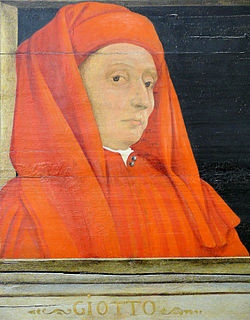Giotto di Bondone Quote
The sincere friends of this world are as ship lights in the stormiest of nights.
Tags:
friendship, light
Related Quotes
People lack morals, good moral character is important in every aspect of your life. Honesty and Integrity opens the door. Your character allows others to see you for who you truly are. Make your first...
Amaka Imani Nkosazana
Tags:
abundance, adventure, aspects, believe, character, complete, completeness, difference, differences, friendship
About Giotto di Bondone
Giotto di Bondone (Italian: [ˈdʒɔtto di bonˈdoːne]; c. 1267 – January 8, 1337), known mononymously as Giotto, was an Italian painter and architect from Florence during the Late Middle Ages. He worked during the Gothic and Proto-Renaissance period. Giotto's contemporary, the banker and chronicler Giovanni Villani, wrote that Giotto was "the most sovereign master of painting in his time, who drew all his figures and their postures according to nature" and of his publicly recognized "talent and excellence". Giorgio Vasari described Giotto as making a decisive break from the prevalent Byzantine style and as initiating "the great art of painting as we know it today, introducing the technique of drawing accurately from life, which had been neglected for more than two hundred years".
Giotto's masterwork is the decoration of the Scrovegni Chapel, in Padua, also known as the Arena Chapel, which was completed around 1305. The fresco cycle depicts the Life of the Virgin and the Life of Christ. It is regarded as one of the supreme masterpieces of the Early Renaissance.
The fact that Giotto painted the Arena Chapel and that he was chosen by the Commune of Florence in 1334 to design the new campanile (bell tower) of the Florence Cathedral are among the few certainties about his life. Almost every other aspect of it is subject to controversy: his birth date, his birthplace, his appearance, his apprenticeship, the order in which he created his works, whether he painted the famous frescoes in the Upper Basilica of Saint Francis in Assisi, and his burial place.
Giotto's masterwork is the decoration of the Scrovegni Chapel, in Padua, also known as the Arena Chapel, which was completed around 1305. The fresco cycle depicts the Life of the Virgin and the Life of Christ. It is regarded as one of the supreme masterpieces of the Early Renaissance.
The fact that Giotto painted the Arena Chapel and that he was chosen by the Commune of Florence in 1334 to design the new campanile (bell tower) of the Florence Cathedral are among the few certainties about his life. Almost every other aspect of it is subject to controversy: his birth date, his birthplace, his appearance, his apprenticeship, the order in which he created his works, whether he painted the famous frescoes in the Upper Basilica of Saint Francis in Assisi, and his burial place.
